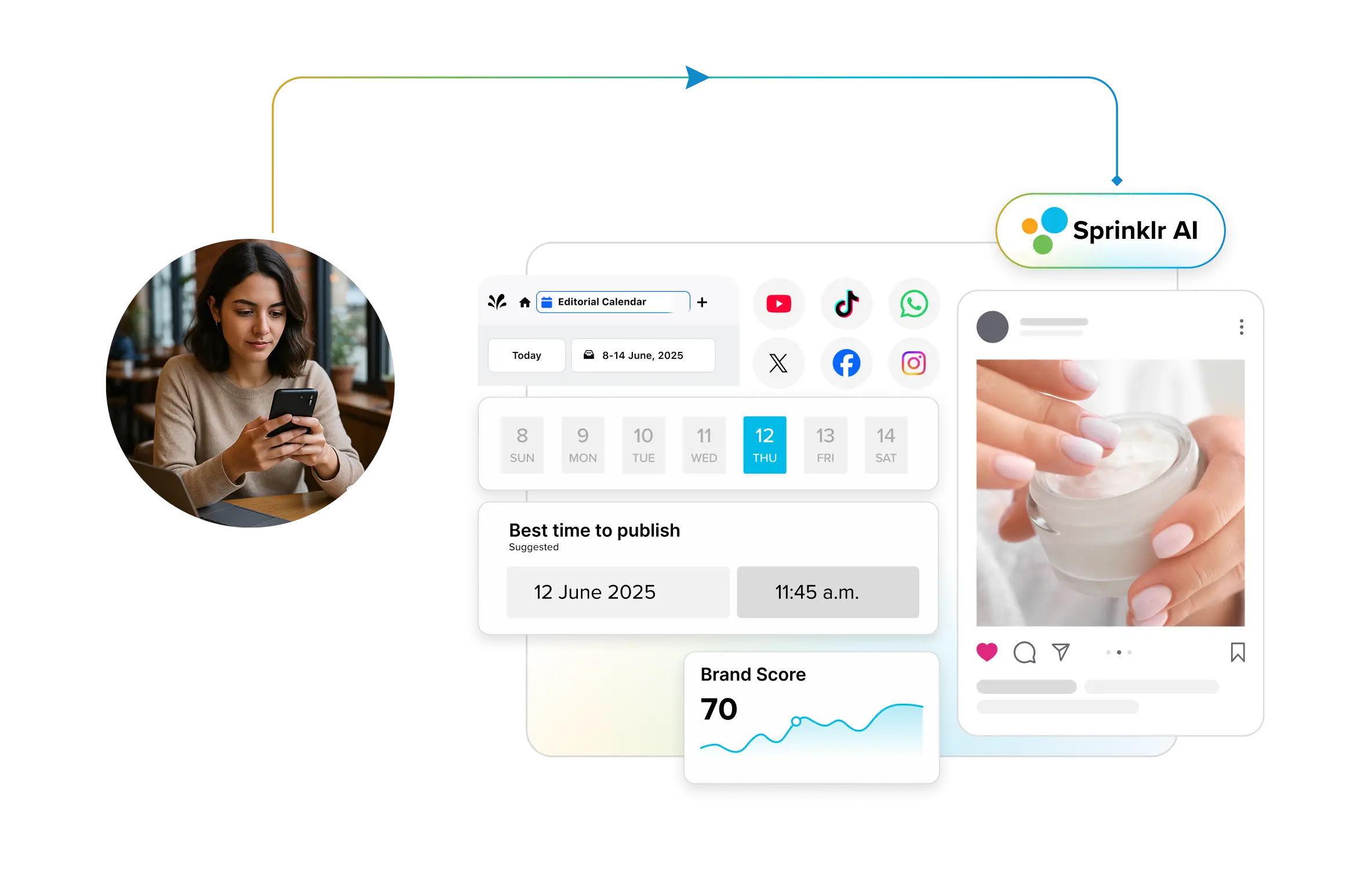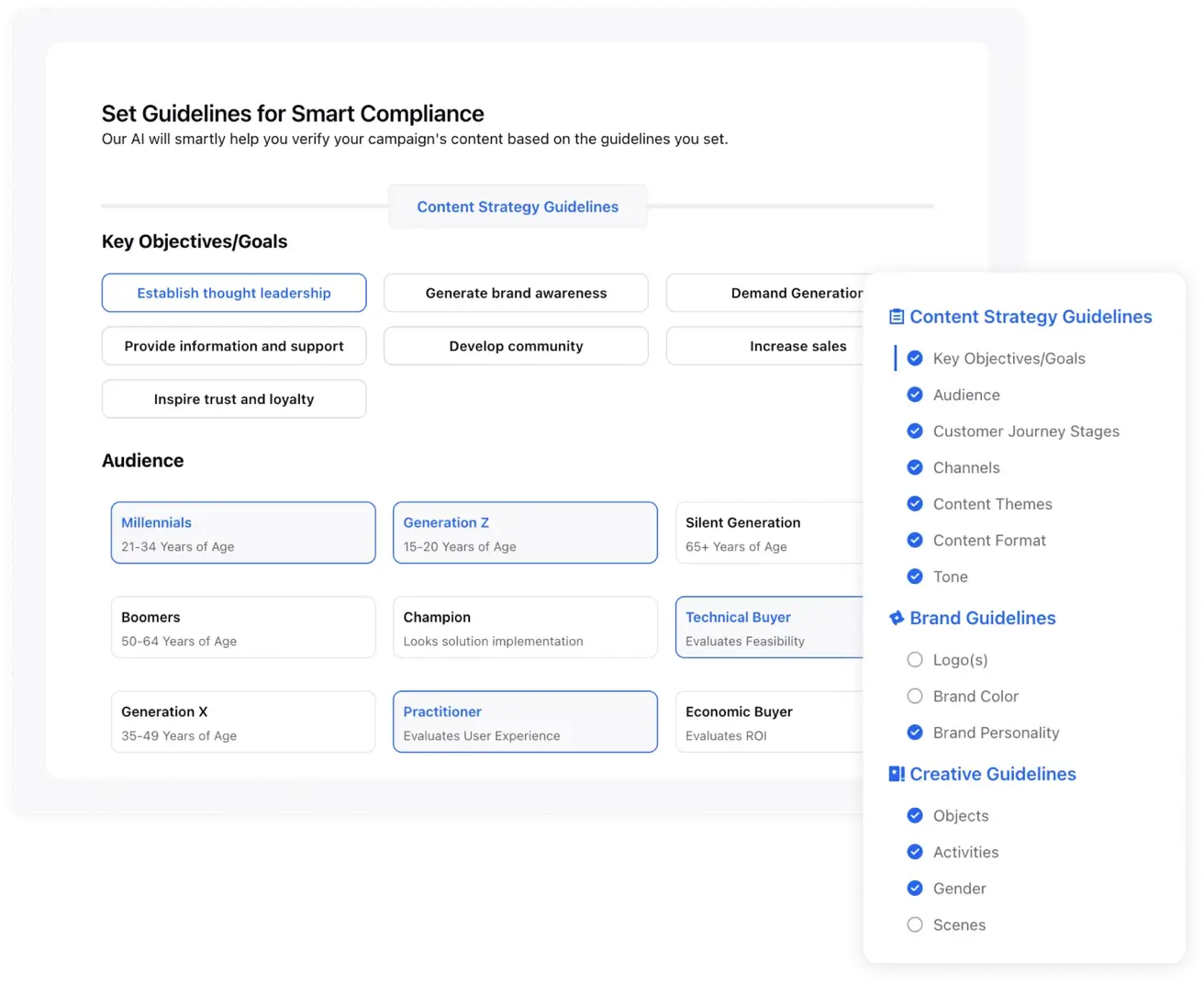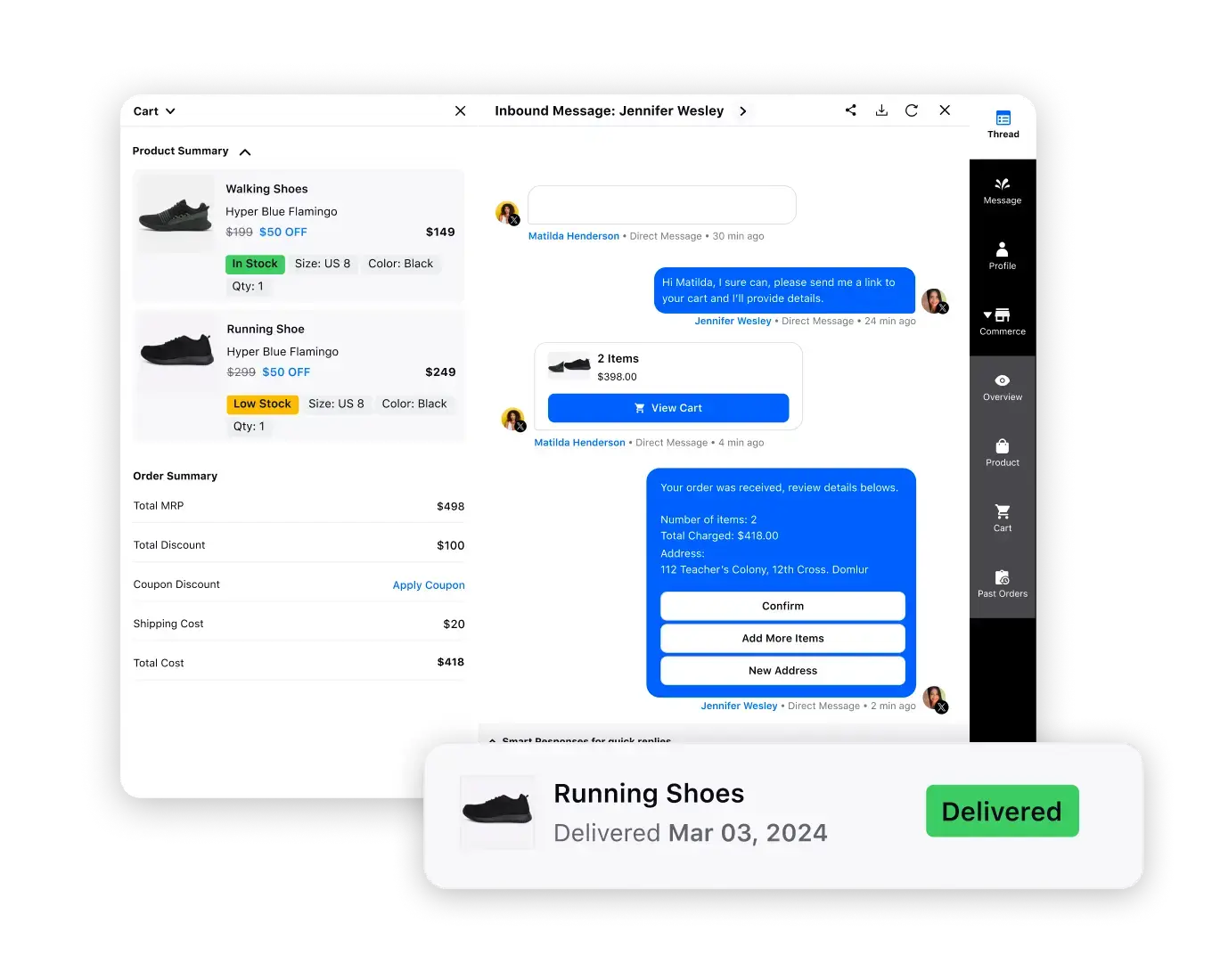The global leader in enterprise social media management
For over a decade, Sprinklr Social has helped the world’s biggest brands reimagine social media as a growth driver with a unified platform, industry-leading AI and enterprise-grade scale.

Social Media for E-commerce: Strategies to Drive Sales, Loyalty and UGC
Social media for ecommerce is transforming how consumers discover, shop, and engage with brands—making it a powerful engine for sales, loyalty, and user-generated content (UGC). From Instagram Shops and TikTok Shop to AI-powered chat experiences, social media is becoming the new storefront.
As audiences increasingly move from traditional e-commerce websites to social platforms, enterprises must adapt quickly. Global social commerce sales are projected to reach $1.2 trillion by 2025, representing nearly 17% of all online retail activity—a clear shift driven by Gen Z and millennial shoppers. For enterprise brands, this shift opens the door to measurable growth: faster conversions, lower acquisition costs, and more authentic engagement through UGC.
In this blog, we explore how e-commerce social media marketing works, with proven strategies, real brand examples and tools to scale content, campaigns and customer care.
What is social media for e-commerce?
Social media for e-commerce involves using online networking platforms to promote products, engage with customers, drive traffic to online stores and facilitate direct purchases. It's about creating a seamless shopping experience that starts and often finishes on the app itself.
For enterprise organizations, social commerce has evolved into a measurable performance channel—not just a marketing tool. Statista forecasts that global social commerce will climb to $8.5 trillion by 2030, growing at a CAGR of 26.2%, highlighting its rapid adoption among younger consumers. Features like in-app checkout, live commerce events, AI-based product recommendations, and customer-generated content are transforming social platforms into essential revenue and loyalty drivers for e‑commerce brands.
The evolving role of social media for e-commerce growth
E-commerce enterprises can no longer ignore social media as its influence spans the entire customer journey. Here’s why:
- UGC is the new product review: 79% of consumers say user-generated content significantly influences their purchase decisions. They find it 9.8 times more impactful than influencer content.
- Always-on engagement is expected: Customers now expect real-time responses via DMs, comments and bots. Social media allows brands to cast a wide net to hear the voice of their customers.
- Community = Conversion: Brands that build authentic communities see higher customer lifetime value.
- Social listening = proactive brand protection: Monitoring sentiment at scale helps catch issues before they escalate.
More to read: Understand Social Commerce: Best Platforms and Trends in 2025
5 proven social media strategies for e-commerce success
E-commerce social media strategies are all about planning, storytelling and selling with purpose. Here are five effective methods to achieve success:
1. Combine paid and organic marketing to maximize ROI
As an enterprise marketer, you can maximize ROI by combining organic and paid social efforts. Start by publishing content organically on platforms like TikTok, Instagram, and YouTube Shorts. Track key metrics such as shares, saves, and video completions to identify what resonates with your audience. Use AI tools like Meta Advantage+ or Sprinklr to find your best-performing content quickly.
Instead of creating new ads, promote these proven posts through paid campaigns. This approach streamlines creative work, reduces testing costs, and helps you get the most value from your social media budget.
For example, The Tiny Tassel, a Black- and Asian-woman-owned accessory boutique based in Charleston, SC, has optimized their Facebook Shop. Their storefront features neatly organized product collections, each with descriptions like “handmade by mom,” creating a curated, trustworthy shopping experience. This setup encourages high click-through from lifestyle content, simplifies the path to purchase and improves first-touch conversion, especially for mobile shoppers.
Also read: Social Media Marketing: Everything Explained for 2025
2. Use shoppable posts and social storefronts to reduce friction
The fewer clicks to checkout, the better. Utilize in-app shopping features to allow direct purchases. Create visually appealing social storefronts. This reduces friction in the buying process.
To optimize performance across channels, teams can use a unified social dashboard to track product-level metrics such as click-through rates, cart additions, and conversion rates. These insights help marketing and merchandising teams identify top-performing SKUs and adjust inventory, creative, or promotion strategy accordingly — turning social into a full-funnel commerce channel.
The paragraph reads like a list of disconnected tips. Unified social dashboard looks inserted without context. Flow gap can be seen
For example, skincare brand Frankly combined its traditional photo ads with Instagram and Facebook Reels ads, following creative best practices. By layering engaging Reels content into its usual ad mix, Frankly achieved 43% more purchases.
3. Launch with teasers, countdowns and drop culture
Product launches aren’t just announcements anymore. They’re serialized stories. Generate excitement for new product launches. Use teaser content, countdown stickers, early-access links and subscriber-only drops to build hype and urgency.
Carefully scheduling this content is essential; posting at optimized times ensures your audience sees the story unfold when they are most engaged. Tools like Sprinklr’s AI-powered content scheduling can help you coordinate teaser content across platforms and automatically optimize post timing based on audience behavior, making your launch strategy seamless and effective.
For example, apparel brand Big Bud Press built up the buzz around their new colorway collection with countdown Stories for their social audience. Such posts drove a sharp rise in email signups, early cart ads and first-hour conversions, showing how social exclusivity can morph curiosity into purchase intent.
4. Pair influencers and creators for broader reach and trust
Consumers today are cautious, almost jaded. They want authenticity, not just endorsements. Collaborate with relevant influencers or creators. Create a strong influencer marketing strategy by combining macro influencers for reach with niche creators for trust and relevance. And choose partners who align with your brand values and target audience. This approach will lead to an uptick in user-generated content, product mentions and repeat purchases.
For example, wellness brand Golde paired micro TikTok creators with wellness routines and recipes using their products alongside larger Instagram influencers. One TikTok creator’s "morning matcha ritual" featuring Golde led to greater brand engagement.
5. Tell stories with behind-the-scenes, founder and community content
Authentic, engaging stories spark conversations and capture audience attention on social media. Social media algorithms prioritize original content that drives higher interaction, so ecommerce brands benefit from sharing behind-the-scenes footage, founder insights, and genuine customer experiences. These stories build trust and deepen emotional connections, signalling value to algorithms and boosting your content’s visibility to the right audience.
For example, sustainable fashion label Tradlands regularly shares behind-the-scenes factory tours, fit-testing videos and candid Q&As with their founder across Instagram. These short-form stories give customers a transparent look at the brand’s values and craftsmanship.
The result? A stronger follower-to-customer conversion rate, more comment-driven engagement and increased saves on product content that follows, indicating a higher intent to purchase.
Apart from utilizing the right strategies, your brand should look into the wide variety of social media platforms to find the ones that suit your requirements. Your enterprise should also learn the most efficient ways to use them to maximize ROI.
Best social media channels for e-commerce growth
With so many platforms and features available, choosing the best social media platform for e-commerce can feel overwhelming. Each social platform has a distinct role to play in planning a seamless customer journey. Here’s how to get the most out of different platforms for e-commerce social media marketing:
1. Instagram
According to Meta, 79% of people have purchased something on Instagram after watching reels. And with over 2 billion active monthly users in 2025, Instagram remains a visual-first powerhouse for product discovery and conversion. Following content formats do well on Instagram:
- Shoppable posts: Tag products directly in lifestyle photos for in-feed discovery and instant checkout.
- Stories and Reels: Use time-limited offers and vertical videos to drive urgency and product engagement.
- Influencer collaborations: Leverage product seeding and collaboration posts to increase brand reach.
For better results, know best Instagram marketing strategy.
2. TikTok
TikTok’s explosive growth continued in 2025. According to the platform, more than 70% of users agreed to the fact that social media platforms have inspired them to make purchases. This underscores TikTok’s potential to turn entertainment into instant sales. Here are few content formats you can focus on:
- Short-form product videos: Create relatable, raw clips featuring product hacks or daily routines.
- Trending challenges: Leverage viral audio or themes to boost visibility and discoverability.
- Creator partnerships: Collaborate with niche creators for authentic storytelling and UGC.
Learn more: How to get followers on Tiktok
3. YouTube
Consumers increasingly turn to video content for product research. YouTube caters to these users with its product explainers, how-to use and review videos.
- YouTube Shorts: Share quick product demos, founder stories or customer testimonials.
- Long-form content: Utilize reviews, unboxing videos and behind-the-scenes footage to establish trust.
- Shopping integration: Enable direct product links below videos for seamless commerce.
To improve your YouTube engagement, know best times to post on YouTube.
4. Pinterest
Pinterest is a visual discovery engine with a strong commercial intent. 80% of weekly Pinners have discovered a new brand or product and the platform sees over 570 million monthly active users in 2025. With native shopping features and searchability, it’s ideal for planning and inspiration-based shopping. Here’s how you can leverage Pinterest:
- Rich product pins: Upload high-quality pins with price, availability and direct links.
- Pinterest shopping features: Create shoppable boards by collection or season.
5. Facebook
Despite growing competition, Facebook remains a dominant player with billions of users globally and the highest number of active marketplace users. 63% of Facebook users browse the platform to discover or research products before purchasing, making it an essential channel for social commerce. Here’s how you can leverage Facebook for e-commerce:
- Facebook Shops: Build a virtual storefront for browsing and buying within the app.
- Targeted ads: Use Advantage+ and custom audience targeting to re-engage cart abandoners.
- Groups and community: Foster brand conversations and loyalty in niche Facebook Groups.
To know more, check out our guide on Facebook marketing.
6. LinkedIn
LinkedIn plays a key role for D2C founders, B2B sellers and value-driven brands. It was rated third among the most important social media platforms for marketing. You can explore the following options on LinkedIn to influence potential customers:
- Thought leadership for D2C founders: Share supply chain insights, founder journey and brand mission.
- Wholesale and B2B sales: Use the platform to attract retail buyers or strategic partners.
- Expert positioning and service marketing: Share insights, publish thought leadership content and engage in niche conversations to build credibility, attract clients and market services.
7. X (formerly Twitter)
X has become a real-time platform for product launches, customer engagement, and brand storytelling. Its large, active user base makes it ideal for flash sales, limited-edition drops, and timely updates that benefit from immediate visibility. Enterprise brands use X to deliver rapid social customer support and publicly address concerns—building trust and transparency. Its informal tone and high shareability also allow teams to experiment with bold, memorable messaging that stands out in a competitive feed.
- Real-time product drops: Announce launches, share early access codes and leverage hunger marketing policies.
- Customer support: Use replies and DMs to resolve queries quickly.
- Brand voice development: Cultivate a distinct, witty or values-driven tone.
Must read: How to get more views on Twitter
Key metrics and tools to gauge social media e-commerce success
Content is only as valuable as the outcomes it drives. Tracking the right KPIs helps e-commerce social media marketing teams measure social media ROI and optimize future campaigns. Focus on:
- Click-through rate (CTR): Your signal of relevance. If people are clicking, you're connecting.
- Add-to-cart and checkout rates: These are your clearest indicators of purchase intent driven by social touchpoints.
- Cost per acquisition (CPA): Tells you whether your social media strategy for e-commerce is working efficiently.
- Engagement rate (ER): Helps evaluate content quality, especially in algorithm-driven environments.
- UGC velocity: Track how much customer content you’re generating. It helps measure brand love and influence.
- Social-attributed repeat purchases: A long-view KPI for how well social drives retention, not just first-time conversion.
Enterprise POV:
As user-generated content becomes a cornerstone of e-commerce marketing, brands must ensure proper governance, moderation and content rights management. This requires robust workflows that protect brand integrity while amplifying authentic customer voices. Sprinklr’s smart compliance tool help curate and filter the UGC they collect. Further, the Digital Asset Management tools make storing and organizing all your UGC in one place so much easier. Together, these capabilities help brands turn UGC into a trusted, high-performing asset

What to use: Tools that power social media marketing for e-commerce
With the right platforms in place, e-commerce teams can move faster, collaborate better and respond in real time to what works and what doesn’t. Here are a few tools to boost your e-commerce social media strategy:
- Sprinklr Social: Sprinklr Social offers a unified platform for managing social commerce across global teams, brands, and channels. With support for 30+ social and messaging platforms, it enables enterprises to centralize publishing, engagement, customer care, and advertising. AI-powered insights help teams analyze audience behavior, optimize content performance, and respond to customer needs in real time.
Features like visual listening, employee advocacy, and conversational commerce are designed to help large organizations scale efficiently while staying brand compliant. For enterprises managing complex social operations, Sprinklr provides the flexibility and governance needed to align marketing, service, and commerce workflows on one platform.
- Google Analytics 4: Tracks how social traffic influences user behavior on-site and connects it to conversions. It supports cross-channel attribution, helping enterprise teams identify high-performing platforms and optimize spend.
- Meta Business Suite: Centralizes campaign insights across Facebook and Instagram. It enables teams to monitor ad performance, understand audience behavior, and manage social commerce experiences within Meta's ecosystem.
For online sellers, the right social media strategy depends on your product type, audience behavior and content style. What matters most is how you adapt to platform trends and evolving shopper expectations.
Pro Tip: Streamlining social media management with an enterprise-grade platform can drastically reduce costs and accelerate growth. Sprinklr Social customers reported a 327% ROI in an independent Forrester study, with benefits including a 10% drop in social commerce abandonment and a 15% lift in average order value. Use AI-powered automation and unified analytics to drive smarter campaigns and elevate the customer journey
Social media trends that drive e-commerce ROI
Winning trends and tactics today are less about volume and more about value. Here are a few social media trends that drive e-commerce ROI:
- Visual-first platforms drive instant discovery: Social media’s visual nature turns browsing into buying. High-quality visuals, short-form videos and immersive content (like AR try-ons or unboxings) help shoppers understand the value of a product without ever leaving the app. Use how-to videos, short tutorials and lifestyle shots to showcase products in real-life contexts.
- Algorithm-driven discovery creates always-on reach: Social media algorithms now prioritize content that keeps users engaged, even when they are not actively searching. This continuous visibility is powered by interest-based discovery, allowing brands to connect with audiences beyond their follower base. E-commerce brands can maintain momentum by publishing timeless content, encouraging UGC, and using interactive formats like polls or live demos. These tactics increase engagement and help platforms surface your content more frequently.
- Campaign strategy leveraging content calendars, always-on vs. burst campaigns: Balance relevant content (like tips or testimonials) with high-impact bursts (like drops or seasonal promos). Encourage testimonials, showcase loyal customers and use DMs or comments to deliver support and deepen relationships.
- Storytelling > Selling and the rise of values-aligned commerce: Shoppers buy into values, not just products. Use founder stories, behind-the-scenes content and mission-driven narratives to build brand affinity and stand out.
- Interactive and engaging formats: Live product demos, polls, Q&As and AR try-ons invite direct participation. These formats increase time spent with your brand, gather feedback and often convert passive viewers into active shoppers. Repurpose strong assets (like reviews or UGC) across formats and leverage platform-native shopping tools to reduce friction from interest to checkout.
Future trends: Preparing for the next wave of social media in E-commerce
Social media is emerging as a decisive channel for discovery, brand engagement, and sales. While it has not fully replaced traditional e‑commerce, its role continues to expand across every touchpoint. Below are five trends enterprise brands must embrace to stay ahead:
1. In-app transactions will become the standard
Social platforms are investing in native checkout, integrated logistics, and payment tools. This shift will allow brands to convert users without redirecting them to external sites, creating a smoother path from engagement to purchase.
2. AI will drive content, targeting, and product recommendations
Generative AI in social media will not only help marketers produce content faster but also automate product tagging, audience targeting, and performance optimization. Brands that connect AI to first-party data will unlock advanced personalization at scale.
3. Creator-powered commerce will dominate the buyer journey
The expanding creator economy and the rise of micro-influencers is inevitable. Micro-influencers currently deliver 2.8 times higher engagement than macro influencers.
Social shoppers trust creators more than brand ads. Platforms are moving toward creator-run storefronts where influencers sell directly to their communities. Brands will need to support and track these efforts to maximize conversion and reach.
4. 1:1 social messaging will power high-intent conversions
Platforms like WhatsApp, Messenger, and Instagram DM are transforming into personal sales channels. Enterprises are adopting chatbot assistants, live agents, and message-based checkouts to support product discovery and drive faster decisions.
5. Decentralized networks may offer new monetization models
Privacy concerns have had an impact on ad targeting and tracking. With cookies and IDs fading, first-party data and contextual targeting are key.
Web3-powered social platforms are introducing user-owned data ecosystems. In the future, brands could reward engagement with tokenized incentives, fostering loyalty and building commerce communities that offer more transparency and control.
Pro Tip: The future of social commerce is fast, fragmented and full of opportunity. Sprinklr equips e-commerce teams with centralized content, rights, insights and engagement in one scalable platform.
Sprinklr’s unified platform helps brands stay ahead by offering features to:
- Plan, schedule and optimize content across Instagram, TikTok, Pinterest and more.
- Discover, moderate and govern user-generated content.
- Seamlessly track creator campaigns, from influencer content performance to paid amplification.
- Spot emerging trends, identify brand risks and tailor messaging with proactive social listening
Result: Your social team leads with insight, agility and a measurable impact on e-commerce growth.

Want to learn more? Book a demo!
Final thoughts
In 2025, social media is the new storefront: visual, fast and community-powered. It is reshaping e-commerce through trends like visual-first discovery, community-led engagement and values-driven storytelling. Platforms such as Instagram, TikTok, YouTube, Pinterest, Facebook, LinkedIn and X each offer unique opportunities to convert engagement into sales. Brands can use strategies like shoppable posts, influencer collaborations, UGC and product launch campaigns to drive conversions, loyalty and long-term growth across these platforms.
Sprinklr Social helps brands do exactly that. From managing large-scale social campaigns and moderating UGC to tracking performance and engaging customers, all in one unified platform. Sprinklr empowers e-commerce teams to scale with confidence and consistency. It can help your teams manage social campaigns, UGC, customer engagement and performance tracking at enterprise scale.
Frequently Asked Questions
User-generated content builds trust by showing real customers using your products. It acts as social proof, often making potential buyers more confident than traditional branded content.
Platforms like Sprinklr Social allow you to manage multiple accounts, schedule posts and monitor engagement from a single dashboard. These tools also offer integrations with analytics and advertising tools to streamline workflows.
Large e-commerce brands can embed shoppable social feeds, feature customer reviews pulled from social platforms and link directly to product pages. These integrations create a seamless path from social discovery to on-site conversion.
Platforms like Instagram and TikTok are highly effective for product discovery and impulse purchases due to their visual and trend-driven nature. However, the effectiveness of any platform depends on your audience’s behavior and where they spend the most time.
Tools like Sprinklr Social, Google Analytics and platform-native dashboards (e.g., Meta Business Suite, TikTok Analytics) help track engagement, reach and conversions. These also provide actionable insights to optimize campaigns.
Most e-commerce platforms offer built-in social media integrations. Alternatively, third-party connectors or APIs can sync your product catalog, customer data and campaign performance.
Consistency matters more than frequency. Use audience insights to determine when your followers are most active and create a posting schedule that keeps your brand visible without overwhelming them.










